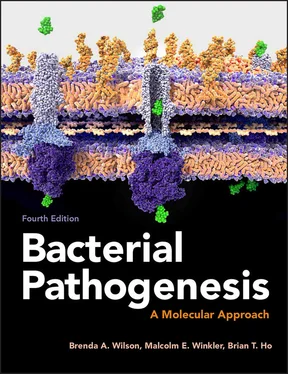e. Provide a possible explanation with rationale for the later symptoms of inflammation and arthritis associated with chronic infections.
5
IN THIS CHAPTER
Importance of the Normal Resident Microbial Populations (Microbiota) of the Human Body
Characterization of the Body’s Microbiota
Taking a Microbial Census by Using Microbial rRNA Gene Sequence Analysis
Characterizing Microbiomes by Using Metagenomic Analysis
Beyond the Metagenome
Overview of the Human Microbiota
Skin Microbiota
Oropharyngeal Microbiota
Microbiota of the Small Intestine and Colon
Microbiota of the Vaginal Tract
The Other Microbiota: The Forgotten Eukaryotes
Selected Readings
Questions
Solving Problems in Bacterial Pathogenesis
CHAPTER 5
The Microbiota of the Human Body
MICROBIOMES AND BEYOND
The ancient Greek philosopher Protagoras of Abdera (ca. 490–420 BCE) famously declared that “Of all things, the measure is Man,” but to the microbes that live in or on us we are more like the proverbial “free lunch.” Yet the microbes colonizing our bodies from shortly after our birth to our death do “pay rent” in various ways. They protect us from disease-causing microbes and contribute to our nutrition and healthy immune status. Our bodies are adapted not only to tolerate these resident microbes, but also to encourage their presence. Indeed, getting in touch with our microbial side is an important part of understanding what it is to be human.
Importance of the Normal Resident Microbial Populations (Microbiota) of the Human Body
A healthy human body harbors more than 10 times as many microbial cells as human cells. These microbes, which include bacteria, fungi, and archaea, are collectively known as the microbiota. Since they do not take up as much space as human cells, their bulk is less than that of the human cells, but their various manifestations can be just as noticeable. For example, the odor of sweat comes from bacterial metabolism of compounds in skin secretions. Bacteria form the film that develops on unbrushed teeth and the plaque that we pay dental hygienists to remove. Even the flatus that we embarrassingly emit is an odiferous indication of the activities of bacteria in the intestine.
Although these particular manifestations of the presence of bacteria are viewed by most as unpleasant, eliminating bacteria from our bodies, even if it were possible, would be a very bad idea. These tiny freeloaders play many beneficial roles in our health. Many members of our resident microbiotas provide us nutrients by degrading foodstuffs that remain undigested by our own systems, such as complex carbohydrates, and by synthesizing and excreting essential vitamins, such as vitamin K, vitamin B12, and other B vitamins.
Normal microbiota also protect us from pathogens by competing for nutrients and occupying potential attachment sites. Indeed, the importance of these resident microbiota becomes particularly evident when they are disrupted or eliminated. For example, a common symptom of taking antibiotics is the development of mild diarrhea as the composition of the microbiota of the colon is disturbed. In more extreme cases, toxin-producing bacteria, such as Clostridium difficile, that are normally present in very low numbers can grow out of control, leading to severe damage of the colon lining and even death. Women who have taken antibiotics that affect the balance of the normal vaginal microbiota often develop vaginitis caused by overgrowth of yeast or vaginosis caused by overgrowth of certain Gram-negative bacteria. Under normal conditions, the vagina is colonized predominantly by Gram-positive Lactobacillus species. When the numbers of these protective Lactobacilli decrease, yeasts and other Gram-negative bacteria can overgrow and produce toxic substances or degradative enzymes that further kill members of the normal microbiota, cause damage to the host mucosa, and ultimately cause disease symptoms, such as foul odor or discharge.
Recent experimental evidence indicates that indigenous bacteria play a crucial inducive role in intestinal development during early postnatal life, particularly in the caecum and Peyer’s patches, as well as in development and maturation of the innate and adaptive immune systems. Colonization by commensal microbiota stimulates the production of cross-reactive antibodies, which are secreted into the lumen of the gut where they prevent infection by related pathogens. Experimental evidence has demonstrated that animals that are born in aseptic conditions and raised in a sterile environment without exposure to microorganisms (germfree animals) have severely underdeveloped immune systems and require substantially more food to maintain the same body weight as others that are raised conventionally.
The notion that maintaining beneficial or “good” bacteria in the intestinal tract is conducive to good health has actually spawned the billion-dollar probiotics industry. Probiotics are preparations of live bacteria, usually freeze-dried into pellets or added to foodstuffs such as yogurt, that are ingested intentionally to bolster the normal population of “good” colonic bacteria or are included in douches to promote a healthy vaginal microbiota. Most of the preparations contain Lactobacillus or Bifidobacterium genera that are common to a particular body site. While the particular strains commonly used in commercial preparations are considered safe, they often do not colonize the host well and so must be taken frequently to maintain the bacteria in the host environment. An alternative approach to maintaining a healthy microbiota that is gaining popularity is prebiotics, which are substances such as fructo-oligosaccharides or nondigestible fiber or “roughage” derived from plants that can alter the composition of the gut microbiota by fostering the growth of “good” bacteria in the large intestine.
Claims for the probiotics currently on the market tend to be vague and very general, but credible scientific evidence is mounting that these preparations may provide some long-lasting health benefits. The idea that probiotics or prebiotics could help patients whose intestinal or vaginal bacterial populations have been disrupted by antibiotics or other factors has attracted new interest for biomedical applications. The hunt for new, targeted therapies that restore optimal balance within microbial communities has already yielded alternative clinical treatment strategies, such as strain supplementation mentioned earlier and prophylactic fecal transplantation to prevent disease from overgrowth of C. difficile. New information on the composition and properties of the normal microbiota of our bodies may further improve the design of effective probiotics.
In a related area, researchers are beginning to exploit our microbiota as a powerful diagnostic tool for assessing health status. For instance, accurate diagnosis of changes in the microbiota might help identify patients who are at higher risk for certain diseases, particularly those diseases whose manifestation correlates with a perturbed microbiota. Ideally, intervention strategies could be initiated sooner and with greater certainty of outcome in these individuals. Understanding the role of our microbiota in health and disease is already having a tremendous impact in the area of precision medicine, an emerging personalized and holistic medicinal approach to disease prevention and treatment that takes into account environmental, lifestyle, life history, and genetic variability of each individual.
Figuring out how to maintain bacterial populations that are conducive to health and then finding ways to capitalize on that knowledge to promote a healthy microbiota is not a trivial undertaking. The microbial populations found in the mouth, intestine, and vagina are complex, not only in terms of the hundreds of different species at each site, but also in terms of the diversity of the metabolic requirements and outputs of those species. Until recently the only way to characterize the microbiota of a particular body site was microscopic visualization and/or laboratory cultivation using various growth media. This approach was not only time-consuming and expensive, but also unreliable because of the poor plating and growth efficiencies of the organisms that are more difficult to cultivate, which often comprise the majority of the bacteria. Additionally, many bacterial species cannot even be cultured in the laboratory. As a result of these challenges, microscopy or culture-based approaches are simply unable to address important questions regarding microbiota makeup, spatial and temporal dynamics, and contribution to health and disease. In order to tackle these unknowns, new technologies and approaches were required.
Читать дальше












